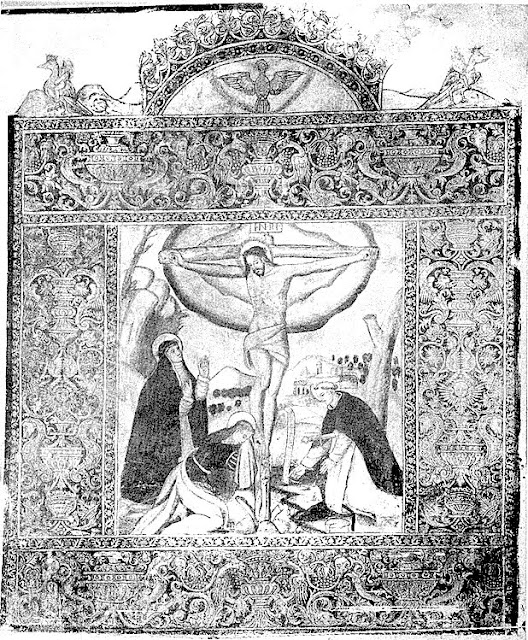On July 25th 1550, Fray Domingo de Aguinaga, the prior of Santo Domingo de Oaxaca, founded a new priory just outside of Cuilapan, an ancient village west of the city—named to celebrate the feast day of St James (Santiago) A major complex was planned, with a seminary, to prepare the Dominicans for missionary work in the Mixteca region of northern Oaxaca.
This ambitious project was never fully completed, and the priory today consists of three main structures: the monumental, unfinished church (3), the attached roofless “Basilica,” formerly an arcaded open chapel (1), and the convento (9)—the only part of the monastery to be finished.
Despite this incomplete state, a number of early murals, some fragmentary, have survived in all three parts of the complex. In this post we focus on two related murals of interest.
In the present sacristy (4), formerly an adjunct to the open chapel, we find the only complete fresco at Cuilapan, a large, monochrome Crucifixion with the two Marys. Restored and in good condition, it is bordered by broad grotesque friezes featuring giant urns, and alive with birds, fruits, flowers and vines.
On the right of the cross, in the place usually taken by St. John the Evangelist, is the kneeling figure of the Dominican saint St. Peter Martyr (San Pedro de Verona), his head cloven by an axe and breast transfixed by a large sword. The turreted building behind him is thought to represent the mission at Cuilapan.
The Convento
Dating from the early 17th century, this spectacular Tree of Dominican Martyrs mural rests in a hallway adjacent to the old refectory (10). Its trunk sprouts from the standing figure of St. Dominic as Protector, sheltering kneeling friars beneath his spreading cloak.
St. Peter Martyr is prominently featured again, in the fork above Dominic, a dagger in his back and an axe in his head, while the crowned Virgin Mary occupies the top spot. The saint also appears on one of the branches.
Rows of diminutive black robed saints and martyrs cluster on the horizontal branches like starlings, each bearing the martyr’s palm. Like the Crucifixion mural, the fresco is framed by ornate, foliated borders.
Although the priory is dedicated to St. James (Santiago) it is interesting that both major murals prominently show St. Peter Martyr, a popular saint throughout Dominican Oaxaca.
The tree scheme is closely based on a highly detailed engraving, Triumphus Martyrum Ordinis Praedicatorum, (The Triumph of the Martyrs of the Order of Preachers) by the Flemish artist Adrian Collaert (1555-1623) published in Antwerp in 1610.
text & graphics © 2017 Richard D. Perry
images by the author, Niccolò Brooker, Felipe Falcón and courtesy of PESSCA











Do you have (or know where I might find) a higher-resolution copy of Collaert's "Triumphus Martyrum Ordinis Praedicatorum"? Thanks!
ReplyDelete